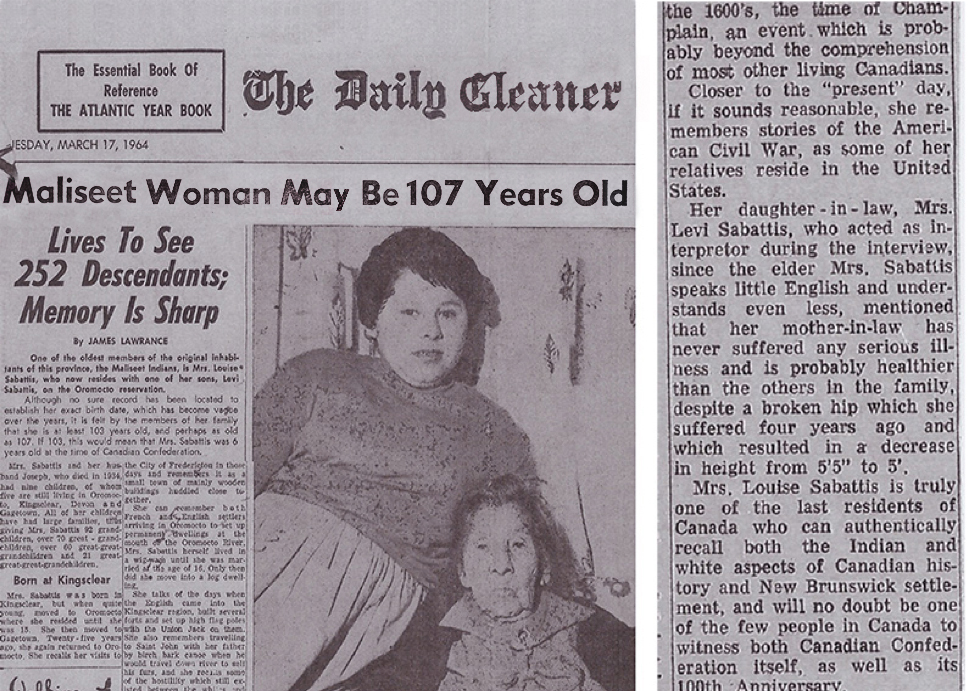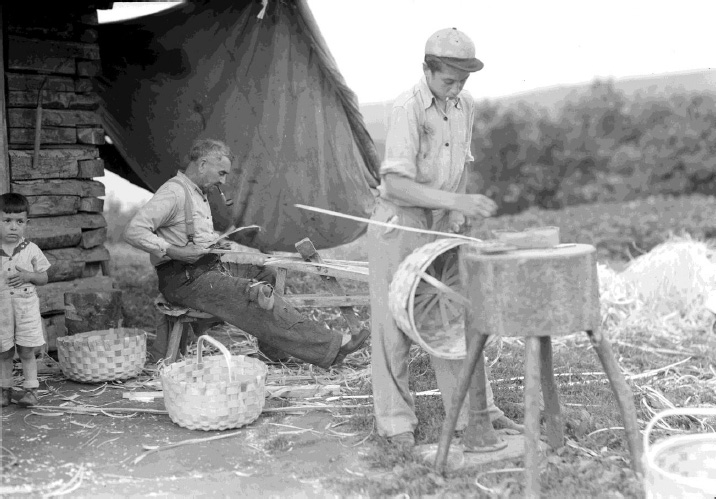Now, read about Mrs. Louise Sabattis from Oromocto. She lived to be more than 107 and had 252 descendants including 21 great-great-great grandchildren. This article was written in March 1964. Do you think she could remember when Canada became a country?
Also, read what John Henry Isaac from Listuguj says. Is he proud to be Mi’kmaw? Why do you think he had to leave home when he was 13 years old?
In the photograph below, what is the young girl doing? Do you think she needs help from her parents? Why or why not?
At home, make a family web of your extended family. Start with you and your siblings. Link them to your parents. Add your parents’ brothers & sisters (=your aunts & uncles). Add their children (= your cousins). Add your parents’ parents (=your grandparents). How far can you go? Do you think you have 252 people in your extended family?
Do you know the Seven Sacred Teachings about the best way to live your life and to be an important part of your family? If so, help make a list of these with your teacher.

Click to read the full article
The Daily Gleaner
Wednesday, March 17, 1964
Maliseet Woman May Be 107
Lives to See 252 Descendants;
Memory Is Sharp
By James Lawrance
One of the oldest members of the original inhabitants of this province, the Maliseet (Wolastoqey) Indians, is Mrs. Louise Sabattis, who now resides with one of her sons, Levi Sabattis, on the Oromocto reservation.
Although, no sure record has been located to establish her exact birth date, which has become vague over the years, it is felt by members of her family that she is at least 103 years old, and perhaps as old as 107. If 103, this would mean that Mrs. Sabattis was 6 years old at the time of the Canadian Confederation.
Mrs. Sabattis and her husband Joseph, who died in 1934, had nine children, of whom five are still living in Oromocto, Kingsclear, Devon, and Gagetown. All of her children have had large families, thus giving Mrs. Sabattis 92 grandchildren, over 70 great grandchildren, over 60 great-great-grandchildren and 21 great-great-great-grandchildren.
Born at Kingsclear
Mrs. Sabattis was born in Kingsclear, but when quite young, moved to Oromocto where she resided until she was 15. She then moved to Gagetown. Twenty-five years ago, she again moved to Oromocto. She recalls her visits to the City of Fredericton in those days and remembers it as a small town of mainly wooden buildings huddled close together.
She can remember both French and English settlers arriving in Oromocto to set up permanent dwellings at the mouth of the Oromocto River. Mrs. Sabattis herself lived in a wigwam until she was married at the age of 16. Only then did she move into a log dwelling.
She talks of the days when the English came into the Kingsclear region, built several forts and set up high flag poles with the Union Jack on them. She also remembers travelling to Saint John with her father by birch bark canoe when he would travel down river to sell his furs, and she recalls some of the hostility which still existed between the whites and Indians at that time, but which is never mentioned in the history books.
Yankee Settling
She also recalls the tales her father and grandfather would tell of the pre-loyalist Yankees settling at Maugerville, and the coming of the British Loyalists to New Brunswick and Nova Scotia and in the 1600’s the time of Champlain, an event beyond the comprehension of most other living Canadians. Closer to the “present” day, if it sounds reasonable, she remembers stories of the American Civil War, as some of her relatives reside in the United States.
Her daughter-in-law, Mrs. Levi Sabattis, who acted as interpreter during the interview, since the elder Mrs. Sabattis speaks little English and understands even less , mentioned that her mother-in-law has never suffered any serious illness and is probably healthier than the others in the family despite a broken hip which she suffered four years ago and which resulted in a decrease in height from 5’5” to 5’.
Mrs. Louise Sabattis is truly one of the last residents of Canada who can authentically recall both the Indian and white aspects of Canadian history and New Brunswick settlement and will no doubt be one of the few people in Canada to witness both Canadian Confederation itself, as well as its 100th anniversary.
John Henry Isaac, Listuguj First Nation
I am from Listuguj. My parents were both Mi’kmaq and there were 15 of us sisters and brothers. Mi’kmaq was the only language spoken in our home until we attended Indian day school at the age of six years. I left home when I was thirteen to help support the family. I left for northern Maine during the potato harvest time. I resided with a farm family for four and half years and adapted to their culture, never forgetting mine. I left there at seventeen and a half years old and worked for the Great Northern Paper Company.
I got married when I was 23 and was blessed with four daughters, two granddaughters, one grandson and three great grandchildren. I worked for the Great Northern Paper Company for 40 years. During all those years I never forgot my culture or who I am. I returned to my home and my roots to live my remaining years in peace. I am involved in my community on issues concerning senior citizens, youth and Mi’kmaq culture.





